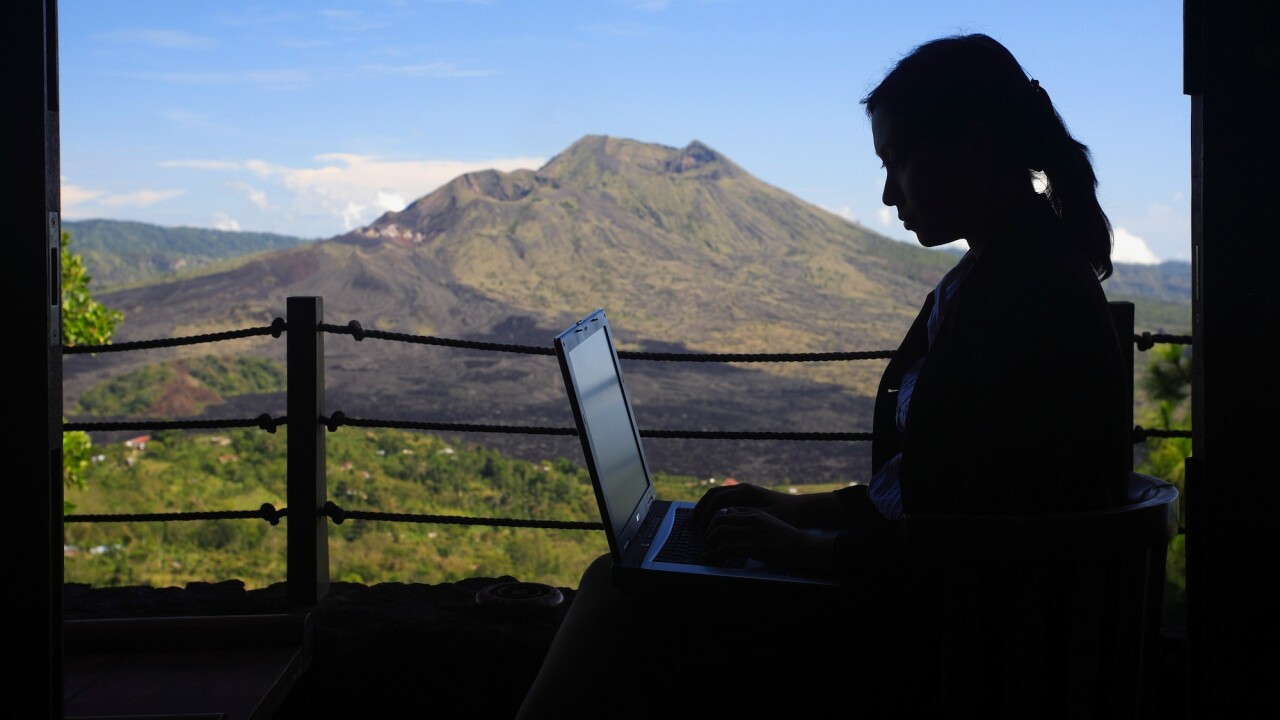
Justin is the Product Manager for Industry Mailout. He’s passionate about building products that delight customers, and also blogs on justinjackson.ca and tweets via @mijustin
Working remotely is a hot topic of debate these past years. Many companies are beginning to allow the flexibility to help cut costs while boosting employee productivity. Then, there are companies like Yahoo that claim remote offices do not help promote company culture or collaborative thinking.
Having just read David Heinemeier Hansson (DHH on the internet) and Jason Fried’s new book “Remote: Office Not Required,” I’m going to describe the ways working remotely (this past year) has affected me personally.
Interruptions
If you missed Jason Fried’s popular TED talk, check out “Why work doesn’t happen at work.” The worst part about being in an office, says Fried, is the amount of interruptions:
Offices have become interruption factories. A busy office is like a food processor — it chops your day into tiny bits.
When I interviewed DHH earlier this year, he talked about the idea of “getting into a zone” while working. He described it as a highly focused, productive state of mind. And then he added another adjective: pleasurable.
Think about the last time you truly enjoyed your work. I felt like this last Saturday: I was able to sit down, late at night, and write about 500 words in an hour. In that hour I didn’t think about anything else: I didn’t check Twitter, email, or take breaks. I was just engrossed in my work; and it truly was pleasurable.
Going to work in an office – with all its “interruptions” – can feel like you’re being handcuffed to a physical location. The remote worker, on the other hand, has the freedom to move away from distractions. Is the TV on? Go to a different room. Coffee shop is too loud? Go home to a quiet room. Traditional offices do not offer this flexibility.
Commuting hell
This is by far the biggest single improvement to my life. Instead of getting in my car and driving one hour from my suburb to downtown Edmonton, Alberta, I jump on my bike and pedal to downtown Vernon in just 10 minutes.
Commuting every day can be anyone’s biggest source of stress. It’s soul-sucking to sit in a car, stuck on the freeway, literally feeling your livelihood slowly vanish into thin air. Even short commutes can make some people unhappy since it disrupts their work flow to devote time to traveling.
My commute was about two hours a day. That’s me spending 10 hours a week, just sitting my car. That’s 480 hours per year. What a waste.
By working remotely, I don’t have to wake up at 5 a.m., before my kids are up, and I’m easily home in time for dinner most days. I feel like I’ve got a huge part of my life back.
We live in the future
Technology companies sometimes surprise me: we pride ourselves on using the latest gadgets, the latest software, the latest coding practices, and the latest development methodologies. And yet so many of these technology companies won’t trust this same technology to enable remote work.
Here’s our toolkit: Campfire (it’s like a digital water cooler), GoToMeeting (video conferencing meetings, and screen sharing), Google Docs (document collaboration and editing), Sprint.ly (task management for software companies), and email.
Using technology for work clears away a lot of the old office abstractions, and allows employees to work more efficiently. The most distracting thing in an office isn’t Facebook – it’s being angry and stressed out from the hour commute you just finished.
Workin’ 9-to-5
Dolly Parton was right: 9-to-5 is a crazy way to make a living. In “Remote,” the authors pointed out two benefits to remote work:
1. It helps you accommodate an individual’s family situation (need to pick the kids up from school?)
2. It allows creative people to work when they’re “in the zone” (are you a morning person, or a night owl?)
The other day we had a crazy morning in the Jackson home. We had a hard time getting the kids ready for school and out the door, and there were a few meltdowns. By the time the dust settled I was in the office at 10 a.m. Knowing that I could start at 10 a.m., and finish at 6 p.m., relieved a ton of stress.
Vernon is my ‘city’
When I was in Edmonton, I longed to be within biking distance of downtown. But like any growing, affluent city (oil money), buying a family home within biking distance carried a serious price tag. I’m lucky to make a good salary, but there’s no way I could afford $500k to $700k on a home.

Vernon, on the other hand, is a small city of 30 to 40,000 people. I was able to buy a medium sized three-bedroom home for well under $400,000. I’m close to downtown, 20 minutes from the ski resort, and 10 minutes to great beaches. When you combine the opportunity to work remotely, with the great lifestyle somewhere like Vernon offers, it becomes a great place to live.
Additionally, working remotely has allowed us to pursue recreational hobbies. I’m able to ski every so often while I’m still in my 30′s, instead of waiting until my 70′s when I (might?) retire.
Go where the talent is
Software companies are desperate for talent; and yet we keep moving our companies to San Francisco where there’s an engineering shortage (and insane salaries). What gives?
37signals, the company which produced “Remote,” is a company many people point to when they talk about success and profits in our industry. Yet they don’t have a single employee in Silicon Valley. The Next Web, the site from which you are reading this article, employs talent from all over the globe.
A company shouldn’t limit the potential for a great team due to the requirement of a physical office.
Remote work, in an office
Remote work doesn’t have to happen in a coffee shop, or at home (surrounded by screaming kids). For example, I work from a small rented office in downtown Vernon. It’s a private office, and it costs $200 per month. The cheapest I could find in Edmonton was $550 per month.
Now take this to a larger company scale, like IBM, for one. Since allowing remote work, the company sold a 58 million square feet commercial space for a profit of $1.9 billion. This downsizing saved the company $100 million a year.
Trade-offs
Sure, there are some downsides to remote work. Without an office, there are:
1. Lack of social interaction, and face-to-face mentoring you get in an office
2. Lack of structure, and the responsibility of managing your own time
3. Difficulties setting boundaries – especially when working from home where there’s the demands of other family members
But given a bit of time, you and your teammates will be able to work something out to collaborate as efficiently as you would if you were in an office together five days a week. The benefits seem to outweight the disadvantages.
Facing the “remote work is crazy” arguments
One of the biggest arguments that people make against remote work is that the best ideas come from meeting in person; sitting around and spit-balling ideas.
Here’s the thing: have you looked at your company’s backlog lately? Often, the challenge isn’t coming up with great ideas — it’s finishing the work on the on ideas you’ve already committed to.
In this way, having frequent brainstorms is less helpful. It’s frustrating, because your idea backlog gets bigger and bigger. You get the rush of coming up with something new, but you don’t finish the slog of grinding out what’s already in front of you.
The second argument that managers often levy, is that when they’re watching their employees (in the office) they know they’re working. This excuse is laughable: you don’t get a sense of what someone’s accomplished by gauging the number of hours they’ve stared at a screen. You can only judge productivity from what’s actually been produced.
There’s an even bigger problem here: who does good work when someone’s staring over their shoulder? If you feel the need to constantly monitor an employee’s productivity, you’ve probably hired the wrong person. No sense in paying someone to do some work — and then have to watch them do it.
Remote work recommendations
Here are some practical tips for companies looking to set-up remote working environments:
Security: use hard drive encryption, secure logins, and device passwords.
The 4-hour overlap: make sure that all your workers have 4 hours of overlap with part of the team.
Use shared screens: tools like WebEx, GoToMeeting, Join.me and screencasting make this possible.
Work transparently: make all your work, discussions and decisions available to everyone at the company.
Have a virtual water cooler: I’ve mentioned this previously. Campfire is a great tool that allows remote employees to hang out, and “play”.
Start slow: start by letting local workers work “remote” for a few days a week. Make sure you try it for 3 months (give it a good shot). Also: don’t just try it with 1-2 employees, try it with the whole team.
Some other perks to improve their quality of life could hurt. Things like providing remote employees with a good desk and chair, gym membership credits, and paying everyone equally regardless of whether they live in cheaper locales are good incentives.
Human interaction
I’m an extrovert: I get energized by being around people. People are surprised when I tell them that I spend most of my work hours, alone, in my office. “Don’t you get lonely?”
I would be lonely if that’s all I did: but I’ve been proactive about building good social networks around me. I host a developers lunch every second week. The last Thursday of every month is Geek Beers. I try to go for coffee two to three times a week. I also host a podcast where I get to talk to people around the world.
If you are the kind of person who needs interaction to feel stimulated, you will find ways to give your brain the added social boost.
Bottom line
Most employees would jump at the chance to work remotely, if the opportunity was given to them. You don’t need to convince them.
It’s bosses that need the convincing. They’re the target that I hope read books like “Remote,” listen to the needs of their employees, and rethink their company culture.
Top image credit: Creativa/Shutterstock
Get the TNW newsletter
Get the most important tech news in your inbox each week.




